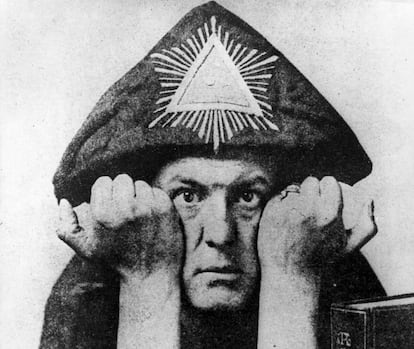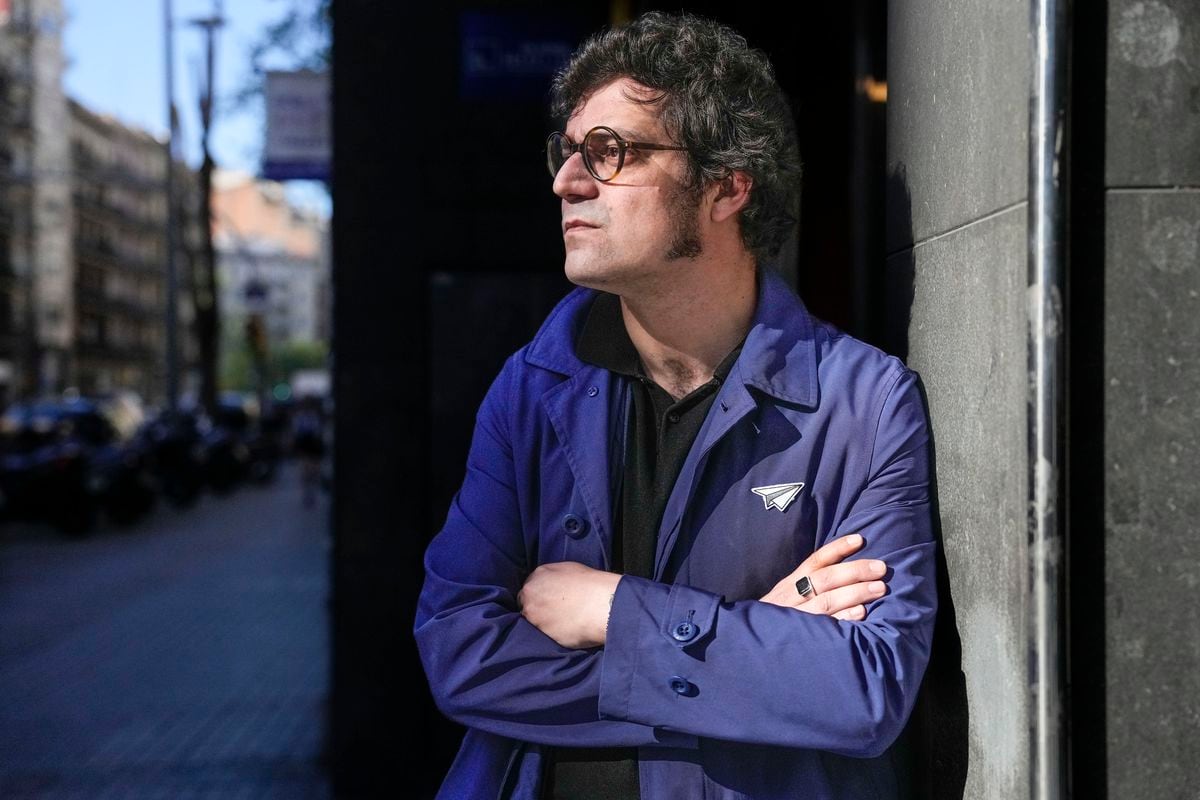The text expands more in its original version, but the basic instructions could be summarized as follows: on the twenty-third day of the month, starting at 11:00 p.m., the person who performs this ritual must concentrate all their energy on their fantasy more intense sex Naked, by candlelight, she will write that wish on a piece of paper that she will later splash with blood, saliva, and genital fluids. Along with a lock of hair and a lock of pubic hair, the note will be sent the next morning to the Temple of Psychic Youth (TOPY) headquarters. Twenty-three consecutive rituals later, the individual will have become a full Initiate of the Temple.
Baptized as
the Eel sigil of the three liquids
(sic), this liturgy based on the sigil symbol —part of the teachings of the influential early 20th-century thaumaturge Austin Osman Spare— provides access to the secret society founded in England in 1981 by, among others, Genesis P-Orridge, multidisciplinary and multi-controversial creator, who died in 2020. A pioneer of industrial rock with Throbbing Gristle and Psychic TV, she was also an emblem of the transgender movement.
Involved in everything that had to do with liberation, P-Orridge had a dream: to unleash the repressed powers of the mind.
Visionary painters such as Hilma af Klint and Remedios Varo rise today as mass phenomena
As postmodernity dictates, its pagan church is sewn with influences: from shamanism to psychedelia, the prophetic theories of social control that Throbbing Gristle developed together with the writers William S. Burroughs and Brion Gysin and, above all, the magic of chaos. , offspring of Spare's theories, in turn a disciple of the supreme sorcerer of our era, the founder of the Thelema religion, the Great Beast 666: Aleister Crowley. The founding texts of TOPY make up the volume
La biblia psíquika,
which the Argentine Caja Negra published a couple of years ago, filling a gap in the Spanish language that had lasted for decades: in the original English, they were written between 1980 and 1990.
'Group X, No. 1, Altarpiece', 1915, by Hilma af Klint (1862-1944).
Heritage Images (Heritage Images via Getty Images)
In the wake of
The Psychic Bible,
A growing number of books dealing with the arcane, the esoteric, the paranormal, the mysterious, the unknown, or—let's agree to call it—the occult, are recently tunneling into the light of Spanish-language literature. Some are fundamental titles —although they are still a minority—, but they had not been translated or only precarious editions existed. Others represent new additions to a fluctuating genre, where there are disparate themes tied by the invisible thread of the transcendental: magic and alchemy, witchcraft and Satanism, astral travel and lysergic trances, spiritism and spirituality, societies secrets and the Freemasons, ufology and astrology, dreams and their interpretations. A revealing fact: as a result of the confinement, online searches for horoscopes skyrocketed.
Occulture
(
occulture ),
a
term probably coined by P-Orridge, is not only in good health in literature, where myths like Lovecraft are resurrected and titles on spells and Wiccanism multiply. It is also manifested in the visual arts (from the ritual
performances
of Marina Abramovic and the spiritist sessions of Suzanne Treister to the publications that decipher the hermetic meanings of the iconography of art, such as
Hidden Relations,
by Sans Soleil), in the series (the
reboot
of
Sabrina; Penny Dreadful
; the Spanish and documentary
Edelweiss
, about the Nazi occult sect…) and in videogames (the sagas
Resident Evil; Silent Hill; Outlast
…). Present since the origins of humanity, with the explosion of the New Age in the 1960s, all these issues have played a relevant role in modern Western society, where the weight of religion —in charge of providing explanations for the inexplicable— has gone irreversibly getting thinner
Painting is surely the medium where the resurgence of the supernatural is most clearly perceived. In their time, around the first decades of the 20th century, artists such as Hilma af Klint, Remedios Varo, and Leonora Carrington enjoyed little or no recognition. Now, those clairvoyants and visionaries, who went hand in hand with the spirits to cross the threshold to higher stages of consciousness, are extolled as mass phenomena. After the Reina Sofía brought to light at the end of last year (and until April) the dark engravings where Belkis Ayón (1967-1999) recreated the rituals of the Afro-Cuban secret society Abakuá, the latest mystical rediscovery is carried out by the Swiss healer Emma Kunz (1892-1963), exhibited for the first time in Spain, until June, at the Tabakalera in San Sebastián.“In times of decadence one returns to what
kitsch
and, when the culture appropriates it, the aesthetic becomes more refined”, explains Pilar Soler, who in 2019 organized the esoteric brut art exhibition
El ojo ojo
Eléctrico in Madrid in 2019 .
For the curator, the search for parallel dimensions is still active and current in the work of creators such as Maya Hottarek, Rachel Garrard and the Spaniards Rosa Tharrats, Felipe Talo and Diego Delas.
Occultist Aleister Crowley (1875-1947), known as the "most evil man in the world."
Keystone (Getty Images)
In a movement against this current, the theoretical basis on which the retrospective that the Reina Sofía dedicated to Mondrian in 2020 was built, curated by Hans Janssen, dismantled a notion that is usually taken for granted: that the Dutch developed his neoplasticism from the precepts of theosophy, a religion founded by the ineffable Madame Blavatsky at the end of the 19th century. Although its influence was minimized in the exhibition (the texts speak of the painter's "erratic incursions" into those lands), that belief, a crossroads of East and West, activated an undeniable creative engine: it inflamed the spirit of artists —Kandinsky, Malevich—, musicians —Alexander Scriabin— and writers —WB Yeats, student of another mystic, William Blake—, whose works aspired to go beyond the frontiers of sensible reality.
Two markedly esoteric periods defined the two halves of the 20th century: one ranged from symbolism to surrealism, the other from New Age to chaos magic. "When you look into the abyss and you don't know what's at the bottom, you begin to think about the transcendent," says Javier Sierra, one of the most prominent figures in this field in Spain, who has been director of the magazine
Beyond science
to coordinator at the Planeta publishing house of a mystery library (Ocultura), with titles such as
The Occultism in Politics
(2017), by Gary Lachman. If in 2019 Mariana Enriquez won the Herralde Prize with a novel about a supernatural heritage and a terrifying secret society,
Our part of the night
(Anagram), two years earlier Sierra won the Planeta Award for
El fuego invisible,
which delves into the myth of the grail. The stories of the Templars, which hatched with
The Da Vinci Code,
by Dan Brown (2003), and which in Spain have Juan Eslava Galán among its supporters, monopolized, as the writer indicates, much of the attention at the beginning of this century XXI. Now the interest circulates in other directions, but they all converge on one point: the need to tread on solid conclusions in a volatile scenario.
Sierra is also at the head of the Ocultura Festival, a reformulation of the term that consecrates each edition to a different unknown. In 2021 they investigated the UFO phenomenon. In previous years they have had Guillermo Solana, artistic director of the Thyssen Museum, talking about mediums and prophets in surrealism and the aforementioned Gary Lachman deepening his vision of the threads that move politics. Former Blondie bassist turned underground guru, some of Lachman's works (
A Secret History of Consciousness; The Lost Knowledge of the Imagination; Rudolf Steiner
) also appear in the catalog of Atalanta, a publisher by Jacobo Siruela who dives into the ocean of the hermetic from a historicist perspective.
Through authors such as the mythologist Joseph Campbell and the philosopher Peter Kingsley, the seal pampers a type of knowledge neglected by nineteenth-century materialism: that which emanates from metaphysical thought, imagination, wonder and visionary experience.
In a volatile context of deep social crisis, people are looking for solid answers
Settled first in León, a "change in sensitivity" caused by the arrival of a new councilor for culture at the City Council forced the Ocultura meetings to be moved to their current headquarters in Zaragoza.
The shadow of superstition cast by the occult is long.
But for those who cultivate it, the innate curiosity of the human being, his sincere admiration for the wonders of the universe, is not only perfect, but also necessarily compatible with the hunger for empirical knowledge.
To paraphrase Arthur C. Clarke, the author of
2001: A Space Odyssey
, "magic is just the science we don't understand yet."
Piet Mondrian.
'composition C (nºIII) with red, yellow and blue', (1935).
photo10
Servando Rocha finishes off that statement: "Science was born from magic: what was first trickery, then was science." Author of titles such as
La horde. A magical revolution
, Rocha directs La Felguera, a publisher with an extensive inventory of noir stories, curiosities and enigmas, with room for grimoires, secret maps and magic beyond traditional spells. An example: the essays dedicated to the return to nature and psychogeography, that is, the act of wandering around the city with the internal antenna alert. "A street acquires powerful properties because suddenly you see beauty where there is none or because it is connected to stories that are still there, flowing", he abounds. “All of that is also connected to the occult.”
At its scale, La Felguera boasts of having published some
best sellers,
volumes such as
WITCH,
(International Terrorist Conspiracy of the Women of Hell, a feminist movement of the late sixties that has risen from its ashes);
The Book of the Law
, Aleister Crowley's bible, and
The Book of the Serpent,
"enlightened" text by comic book writer and writer Alan Moore.
"For me, the greatest philosopher there is right now," says the editor about the author of V for vendetta, one of the most notorious defenders of chaos magic, whose ranks he joined on his 40th birthday in a prospect towards the self-knowledge that he recounted in Fossil Angels, an essay also published by La Felguera.
Even though they are "very
underground
", projects like Servando Rocha's have achieved —as the writer and translator Javier Calvo points out— something remarkable: that the occult sciences come out of "those horrifying editions that were only sold in crystal stores".
Still from the series '30 Coins', by Álex de la Iglesia, with Cosimo Fusco in the role of the devil.
MANOLO PAVON (HBO)
Started in the seventies, the magic of chaos is for those responsible for the Sui Generis Festival in Madrid —which promotes reading from the noir genre in a broad sense—, one of the most powerful currents of attraction today. With stealth as its basic tool, it is the force that propelled The KLF to burn a million pounds and the one that empowers Marvel's Scarlet Witch. “It is a movement that arises from punk, based on the do-it-yourself philosophy,” explains Alberto Ávila, advisor to the festival and collaborator with Aurora Dorada, an editorial of Carlos Maroto Pla focused on rescuing germinal titles of these issues in Spanish, such as
Liber Null .
,
by Peter J Carroll.
"It's a magic that doesn't require complex rituals, that allows you to take what works for you, that attracts youth... It's pure pop culture."
The popular makes up, in effect, the substratum from which many of the subjects linked to the occult are nourished.
From the songs of the Beatles —of which it was speculated that they recited diabolical messages when played backwards— to aliens, on which rivers of ink have run, although many had fallen into a black hole in the Spanish edition.
The efforts of Anómalas Reeditions, a "fortean" and "almost one-person" project (as are other publishers versed in the paranormal) by Pablo Vergel, professor of sociology at the University of Alicante and regular collaborator of
Cuarto Milenio
, the well-known mystery program by Iker Jiménez.
The label has reissued out-of-print star titles (which, according to the editor, were sold at a gold price on the internet) such as
Passport to Magonia,
in which the French scientist and ufologist Jacques Vallée introduced the psychic and folkloric component to the UFO interpretation, and
The message from other worlds,
abduction testimony of the Spanish historian Eduardo Pons Prades.
'Messengers', 1932, by Agnes Pelton.Craig Smith
From the role of the enthusiast, but also the scholar, Vergel defends that aliens embody "a vector that helps to understand much of society." Before the 1940s, those who appeared were God and the Virgin. Surely due to the exponential development and dissemination of science, sightings of Martians began to proliferate, whose mythology was gaining followers until it was crowned "the great phenomenon of the 20th century". Today, the attention they garnered has been deflated by the prick of reality: there is "not a single piece of evidence" that anyone is out there. "But Kant already said that there are questions that have no answer: the origin of life remains an unfathomable mystery," says Vergel. Humans are machines that search for meanings and, sometimes,the paranormal “ends up giving more satisfactory answers”.
That visions of flying saucers have acquired a universal character is largely due to the expansive capacity of cinema. However, for the critic Jesús Palacios —who has published a handful of books on film occultism, the latest
The esoteric screen,
at UOC—the true obsession of the films is something else: the arrival of the antichrist. "Cinema has an intrinsic magical power: it revives the dead, it evokes impossible creatures...", argues Palacios, who highlights directors such as Alejandro Jodorowsky in contemporary times, and Maya Deren and Kenneth Anger ("Crowley's filmmaker"), among others. the past ones "There are two types of films: those that use the occult as a theme, sometimes simply to entertain, and those that use celluloid to investigate magic itself," he abounds. Those of these artists, of course, would fall into the second category.
In pursuit of elusive illuminations, films have been shot, potions have been cooked, souls have been invoked and meetings have been held in the third phase. It has been done throughout history by ordinary people and lofty names from the arts to music, from Leonardo da Vinci to Arnold Schönberg. About the lost musical treatise of the Florentine and the Austrian's fondness for numerology, Luis Antonio Muñoz writes in his book
Hidden History of Music
(The sphere of books), whose pages parade Rosicrucians, followers of Gurdjieff's fourth way and musical geometers, and among them the freemason Mozart and his satanic majesties, the Rolling Stones. Eugene Thacker reflects on more recent genres such as black metal in his trilogy
The Horror of Philosophy
(Dark Matter), where he relates this demonic branch of heavy metal with concepts such as what he calls Cosmic Pessimism, rooted in Kierkegaard's thought.
'Snowy Peak Beyond the Slopes', painting by Aleister Crowley from 1934. Aleister Crowley © Ordo Templi Orientis
Pointing the spotlight towards the darkness does not imply for Muñoz to try to convince of anything, much less fight against the enlightened forces.
It is simply about telling a part of the story that, perhaps because it is uncomfortable or misunderstood, has been left out.
“What we have to ask of literature and research”, demands the musician, “is seriousness so that the data allows people to verify and create their own theories”.
The materialism of the XIX has neglected the metaphysical thought based on the imagination
It is, neither more nor less, to go out in search of answers. "One of the art revolutions of the 20th century was the interest in meaning, and the hidden provides very beautiful metaphors," says curator Enrique Juncosa, responsible for
La luz negra
, a 2018 exhibition at the CCCB in Barcelona around secret traditions. At the close of that display of cabalistic works by Barnett Newman, Antoni Tàpies, Agnes Martin and living artists such as Zush, Francesco Clemente and Joan Jonas, the success achieved among critics and audiences was ratified. But beforehand it was not easy to locate information (Mircea Eliade and Carl Jung were key) and even less convincing of the proposal. "It was a matter of concern," he recalls. The ghost of quackery lurked. "But it is perfectly possible to make a rational account of something irrational."
If there is a unit of magnitude that homogenizes the spiritual aspirations of artists, that would be, for Juncosa, the sublimation of "the powers of the mind." The longing to push the limits of human capabilities and tear a peephole into the inconceivable vastness of the universe provides drive and motivation for every dark side explorer's journey. Locked up and crouched behind the masks, stuck in a context of endless crisis, people, as the commissioner summarizes, need, today more than ever, "to find meaning in things". It is not strictly necessary to undress or spray papers with body fluids as P-Orridge demanded: it is enough to immerse yourself in a book, enter a painting, lose yourself in a movie. What else are we talking about when we talk about the magic of art?
Mediums, philosophers and esotericism bestseller
From Steiner to infinity.
The collective exhibition
Joseph Beuys: Antecedents, Coincidences and Influences,
at the Helga de Alvear Museum in Cáceres (until May), delves into the ideas that shaped the German's thought.
His conception of art and life is tied to anthroposophy, Rudolf Steiner's philosophy around the possibility of accessing the spiritual world from three axes: imagination, inspiration and intuition.
Artist, medium and peasant.
With a colorful and charmingly naive style, the drawings of the Catalan peasant Josefa Tolrà (1880-1959), made in a mediumistic trance, materialize the "beings of light" with whom she established contact. His work, now in important collections, went unnoticed by almost everyone except the poet Joan Brossa. In 2014, a retrospective in Barcelona confirmed its rediscovery.
Lights in New Mexico
. Helena Blavatsky's theosophy spurred creative minds on both sides of the Atlantic. Settled in New Mexico, USA, in the 1930s, the so-called Transcendental Pictorial Group amalgamated the ideas of the Russian prophet with those of Steiner, Kandinsky... to paint the colors of illumination. Forgotten for decades, both collectively and represented by members like Agnes Pelton, those artists are currently the stars of major exhibitions and laudatory articles in the press.
Best selling esotericism
.
Before Dan Brown intoxicated half the planet with his conspiracies,
The Eight
(1989), by Katherine Neville – which combines history, chess, alchemy and Freemasonry – laid the foundations for best-selling esotericism.
For the author, the fact that the novel remains "alive and relevant" is explained by its "cosmic connections": "The ones we all have with the hidden (or unresolved) mysteries of the universe."
All Satan.
More than one writer has made a pact with the devil and countless others have invoked him in their literature.
The Great Book of Satan
(Blackie Books) brings together dozens of texts in a complete volume: from Mark Twain to Samanta Schweblin, 666 pages of bad, very bad narrative.
Imagination to the power.
For the alchemists, the "secret fire" was the ingredient of the philosopher's stone. Hence the title
The Secret Fire of the Philosophers,
by Patrick Harpur, (Atalanta), a multidimensional history of the imagination through myth, poetry, science and psychology, from which a sad conclusion is drawn: inventiveness goes through low hours .
The most evil icon in the world.
The English magician Aleister Crowley (1875-1947) was and still is a pop icon, admired by Led Zeppelin and David Bowie. Among the large bibliography that has inspired, Golden Dawn (which takes its name from the society in which Crowley, Bram Stoker, HG Wells... participated) published in December the biography considered definitive of the "most evil man in the world":
Perdurabo
, by Richard Kaczyński.
The dark side of Álex de la Iglesia.
No Spanish filmmaker has traveled the dark side like Álex de la Iglesia. From the antichrist of
El día de la Bestia
(1995) to the witches' coven
of Zugarramurdi
(2013), his work exudes esotericism. In
30 Coins
(2020), a series starring an exorcist, the demon appears covered in occult symbols inspired by a publication by La Felguera: Encyclopedia of the Dark Arts. In Hollywood, Nicolas Cage does not stop interpreting and producing occult films.
A psychomage of celluloid.
The Chilean Alejandro Jodorowsky, "psychomagician", tarot reader and co-founder of the Panic Movement, linked to pataphysics, has shot films of high mystical voltage.
In La Montaña Sagrada (1973) he had the advice of the Bolivian shaman Óscar Ichazo (1931-2020), creator of the Arica School, which offers a "contemporary method" to achieve enlightenment.
Not so subliminal messages.
Bands like Coven and Black Sabbath inaugurated the Occult Rock current at the end of the sixties, with lyrics with occult messages.
This century the trend has returned with groups like Lucifer, Orchid and, in Spain, Pylar.
Futuro Terror, a punk group, cultivates mystery and ufology in their songs.
You can follow BABELIA on
and
, or sign up here to receive
our weekly newsletter
.
Sign in to continue reading
Just by having an account you can read this article, it's free
RegisterLogin
Thanks for reading THE COUNTRY







/cloudfront-eu-central-1.images.arcpublishing.com/prisa/5A62GKBSS5A4ZP7P7EXCREVLGE.jpg)

/cloudfront-eu-central-1.images.arcpublishing.com/prisa/6CHDRQ5XQBCYJNCQNWVWDVWB74.jpg)





